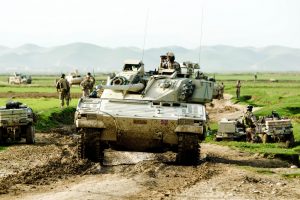Can BAE’s CV90 Roll From European Success To US Army NGCV?
Posted on
AUSA: In a promising sign for the US Army’s Big Six modernization plan, not one but three different companies have invested their own money in full-up working vehicles for the Army’s Next Generation Combat Vehicle (NGCV) project:
- BAE Systems, which makes the current M2 Bradley Infantry Fighting Vehicle, a heavily armed and armored troop carrier that NGCV aims to replace. BAE is offering the latest version of their CV90 infantry fighting vehicle, the Mark IV, which features in the video above & is detailed below.
- General Dynamics, which makes both the massive M1 Abrams main battle tank and the (relatively) lightweight eight-wheel drive Stryker (click here for our video tour of GD’s NGCV offering); and
- an upstart team of Raytheon, best known for electronics, and Germany’s Rheinmetall, offering what they’re calling the Lynx (click here for that video).
Now, these aren’t prototypes, but the military equivalent of concept cars, designed to show off their manufacturers’ technology and get discussion going on what the final mass-produced product should like like. But there’s one big difference.
CV90: The Evolutionary Option
GD’s Griffin and the Rheinmetall-Raytheon Lynx are demonstrators, taking components from current vehicles but putting them together in all-new designs never mass-produced anywhere. By contrast, BAE is offering an evolutionary upgrade, albeit a substantial one, of a vehicle that entered service in Sweden in the 1990s and has since sold well across northern Europe.
The upside of that strategy is a well-established track record, including combat experience in Afghanistan, with decades spent working out the bugs in the design. The downside is that it doesn’t allow for some of the radical advances that the competitors can offer. Whether the Army wants to play it safe or stretch is a fundamental question the service will have to decide.
Subscribe to our newsletter
Promotions, new products and sales. Directly to your inbox.

